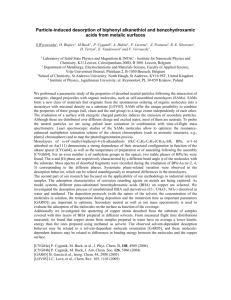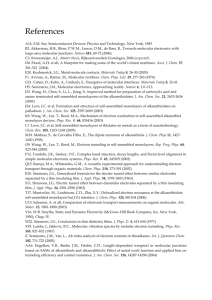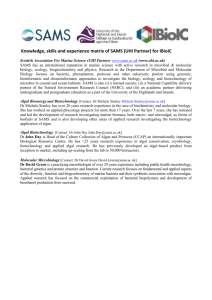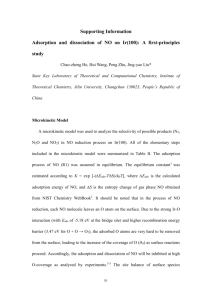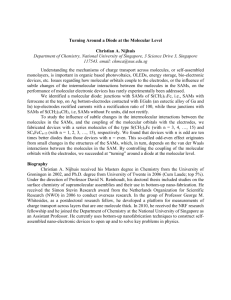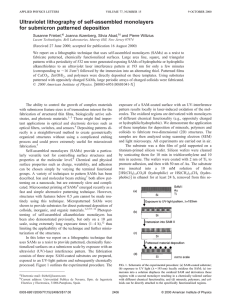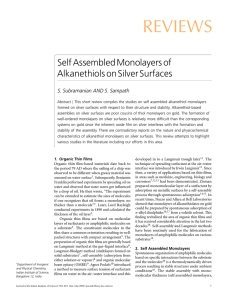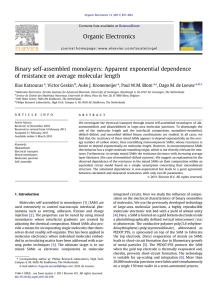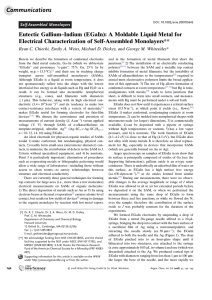View/Open - Lirias
advertisement
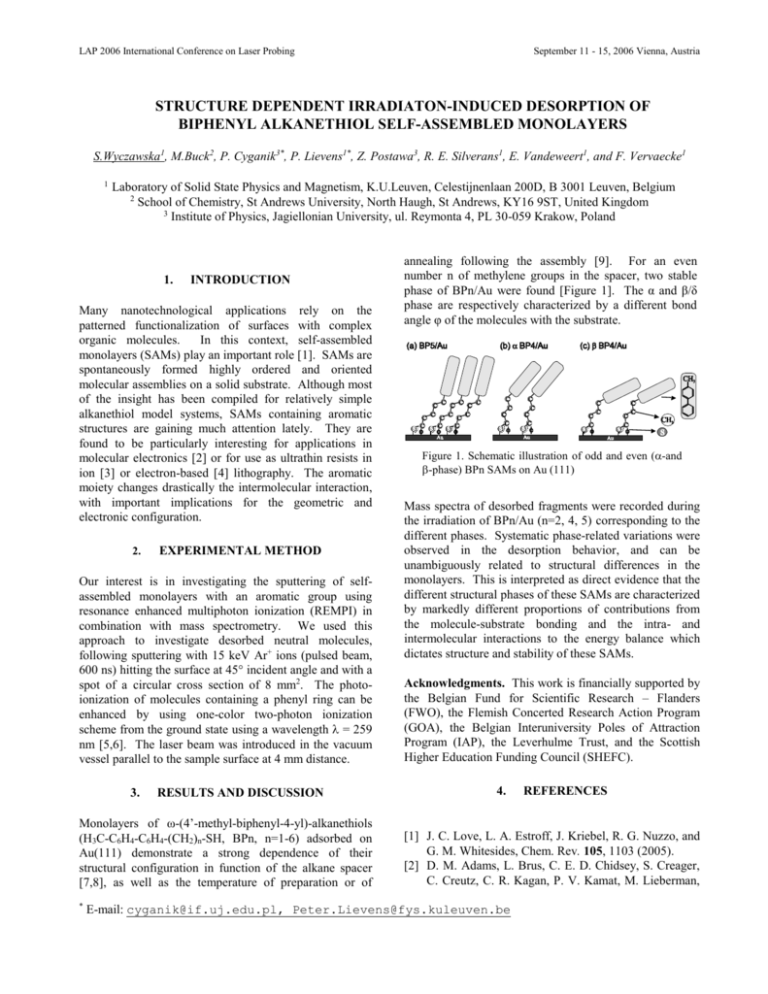
LAP 2006 International Conference on Laser Probing September 11 - 15, 2006 Vienna, Austria STRUCTURE DEPENDENT IRRADIATON-INDUCED DESORPTION OF BIPHENYL ALKANETHIOL SELF-ASSEMBLED MONOLAYERS S.Wyczawska1, M.Buck2, P. Cyganik3*, P. Lievens1*, Z. Postawa3, R. E. Silverans1, E. Vandeweert1, and F. Vervaecke1 1 Laboratory of Solid State Physics and Magnetism, K.U.Leuven, Celestijnenlaan 200D, B 3001 Leuven, Belgium 2 School of Chemistry, St Andrews University, North Haugh, St Andrews, KY16 9ST, United Kingdom 3 Institute of Physics, Jagiellonian University, ul. Reymonta 4, PL 30-059 Krakow, Poland 1. INTRODUCTION Many nanotechnological applications rely on the patterned functionalization of surfaces with complex organic molecules. In this context, self-assembled monolayers (SAMs) play an important role [1]. SAMs are spontaneously formed highly ordered and oriented molecular assemblies on a solid substrate. Although most of the insight has been compiled for relatively simple alkanethiol model systems, SAMs containing aromatic structures are gaining much attention lately. They are found to be particularly interesting for applications in molecular electronics [2] or for use as ultrathin resists in ion [3] or electron-based [4] lithography. The aromatic moiety changes drastically the intermolecular interaction, with important implications for the geometric and electronic configuration. 2. EXPERIMENTAL METHOD Our interest is in investigating the sputtering of selfassembled monolayers with an aromatic group using resonance enhanced multiphoton ionization (REMPI) in combination with mass spectrometry. We used this approach to investigate desorbed neutral molecules, following sputtering with 15 keV Ar+ ions (pulsed beam, 600 ns) hitting the surface at 45° incident angle and with a spot of a circular cross section of 8 mm2. The photoionization of molecules containing a phenyl ring can be enhanced by using one-color two-photon ionization scheme from the ground state using a wavelength = 259 nm [5,6]. The laser beam was introduced in the vacuum vessel parallel to the sample surface at 4 mm distance. 3. RESULTS AND DISCUSSION Monolayers of ω-(4’-methyl-biphenyl-4-yl)-alkanethiols (H3C-C6H4-C6H4-(CH2)n-SH, BPn, n=1-6) adsorbed on Au(111) demonstrate a strong dependence of their structural configuration in function of the alkane spacer [7,8], as well as the temperature of preparation or of * annealing following the assembly [9]. For an even number n of methylene groups in the spacer, two stable phase of BPn/Au were found [Figure 1]. The α and β/δ phase are respectively characterized by a different bond angle φ of the molecules with the substrate. Figure 1. Schematic illustration of odd and even (-and -phase) BPn SAMs on Au (111) Mass spectra of desorbed fragments were recorded during the irradiation of BPn/Au (n=2, 4, 5) corresponding to the different phases. Systematic phase-related variations were observed in the desorption behavior, and can be unambiguously related to structural differences in the monolayers. This is interpreted as direct evidence that the different structural phases of these SAMs are characterized by markedly different proportions of contributions from the molecule-substrate bonding and the intra- and intermolecular interactions to the energy balance which dictates structure and stability of these SAMs. Acknowledgments. This work is financially supported by the Belgian Fund for Scientific Research – Flanders (FWO), the Flemish Concerted Research Action Program (GOA), the Belgian Interuniversity Poles of Attraction Program (IAP), the Leverhulme Trust, and the Scottish Higher Education Funding Council (SHEFC). 4. REFERENCES [1] J. C. Love, L. A. Estroff, J. Kriebel, R. G. Nuzzo, and G. M. Whitesides, Chem. Rev. 105, 1103 (2005). [2] D. M. Adams, L. Brus, C. E. D. Chidsey, S. Creager, C. Creutz, C. R. Kagan, P. V. Kamat, M. Lieberman, E-mail: cyganik@if.uj.edu.pl, Peter.Lievens@fys.kuleuven.be LAP 2006 International Conference on Laser Probing [3] [4] [5] [6] [7] [8] [9] S. Lindsay, R. A. Marcus, R. M. Metzger, M. E. Michel-Beyerle, J. R. Miller, M. D. Newton, D. R. Rolison, O. Sankey, K. S. Schanze, J. Yardley, and X. Y. Zhu, J. Phys. Chem. B, 107, 6668 (2003). E. T. Ada, L. Hanley, S. Etchin, J. Melngailis, W. J. Dressick, M. S. Chen, and J. M. Calvert, Vac Sci. Technol. B, 13, 2189 (1995). A. Gölzhäuser, W. Geyer, V. Stadler, W. Eck, and M. Grunze, J. Vac Sci. Technol. B, 18, 3414 (2000). E. Vandeweert, J. Bastiaansen, F. Vervaecke, P. Lievens, R.E. Silverans, P. Cyganik, Z. Postawa, H.T. Rong, and M. Buck, Appl. Phys. Lett. 82, 1114 (2003). P. Cyganik, E. Vandeweert, Z. Postawa, J. Bastiaansen, F. Vervaecke, P. Lievens, R. E. Silverans, and N. Winograd, J. Phys. Chem. B 109, 5085 (2005). H.-T. Rong, S. Frey, Y.-J. Yang, M. Zharnikov, M. Buck, M. Wühn, C. Wöll, and G. Helmchen. Langmuir, 17, 1582 (2001). P. Cyganik, M. Buck, et al. J. Phys. Chem. B, 108, 4989, (2004). P. Cyganik and M. Buck, J. Am. Chem. Soc. 126, 5960 (2004). September 11 - 15, 2006 Vienna, Austria
